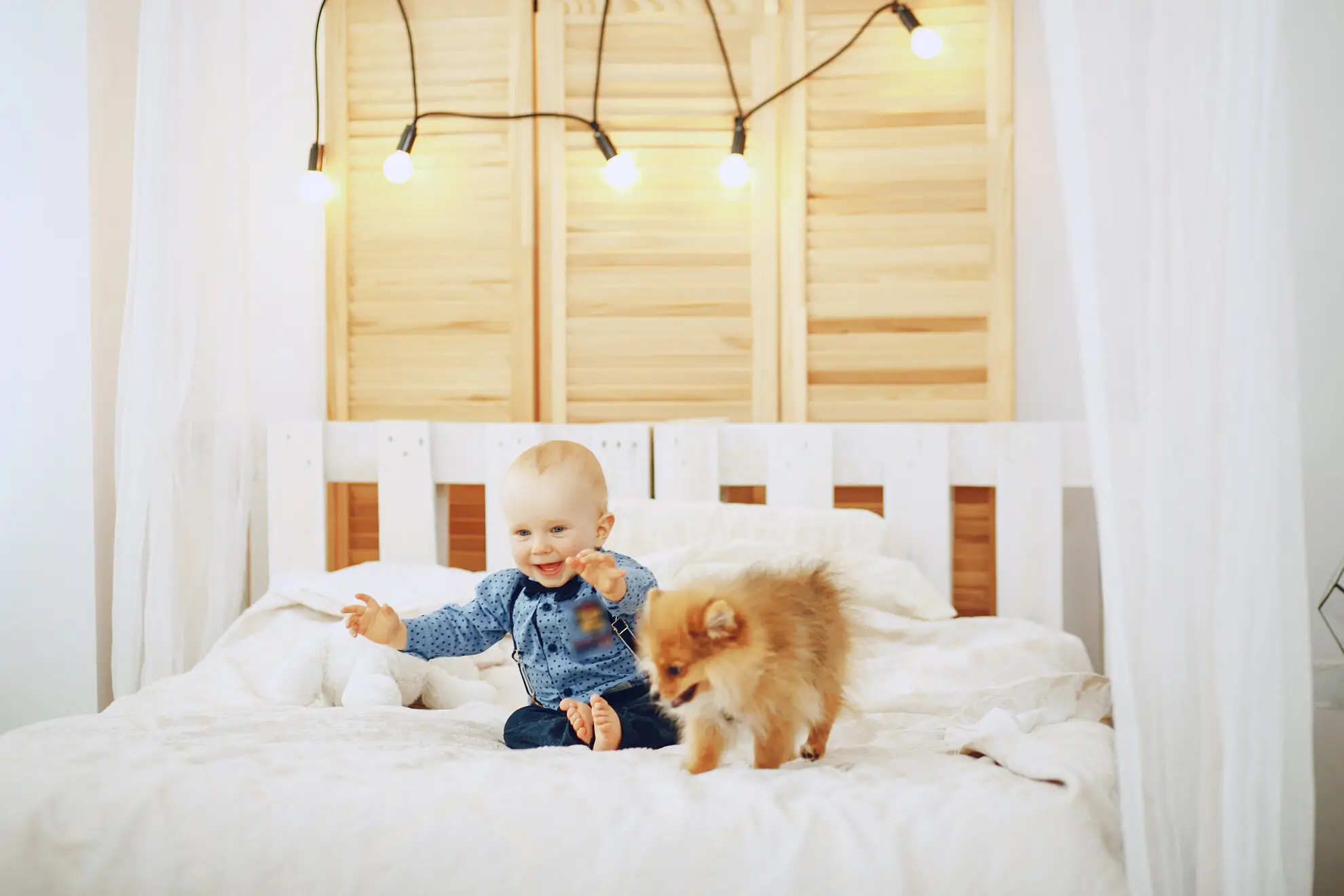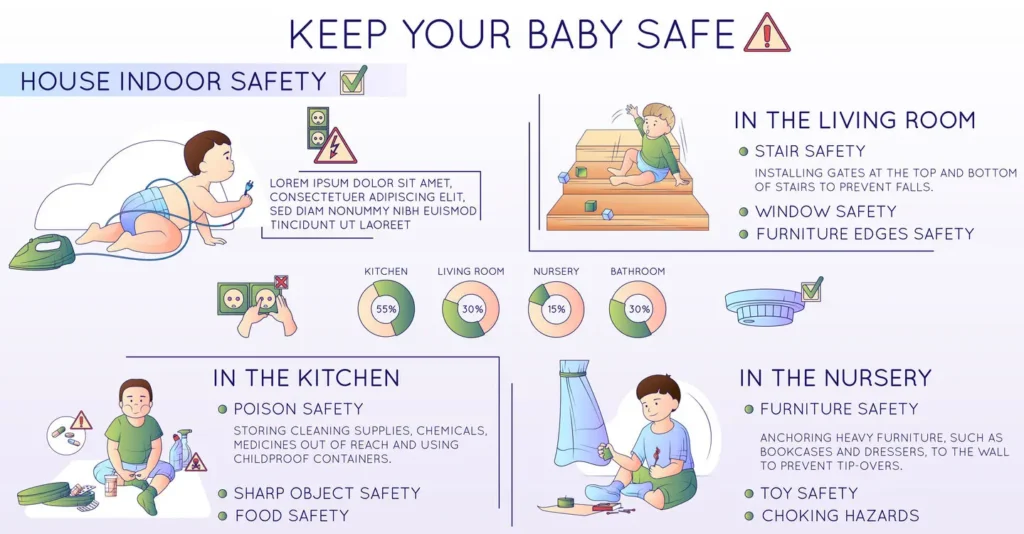Room sharing means the baby sleeps in the same space as caregivers on a separate, safe surface. It keeps checks easy, helps nights feel calmer, and works in small homes. You can start with a crib or bassinet in the parents room and a cool-comfortable baby’s room temperature. When ready, use the same routine in the infant room to plan when to move baby into own room.
What is room sharing
Types of Room Sharing
Beyond the main list above, these variants help real homes:
- Work-shift layout: One adult rests in the living area during night shift weeks while the baby remains in the bedroom; still separate surfaces, same routine words.
- Loft or studio plan: Mini crib behind a freestanding screen; keep the screen at a safe distance to maintain airflow.
- Seasonal switch: In hot months, move the bassinet to the coolest corner to keep baby’s room temperature steady; in cold months, slide away from drafty windows.
- Temporary caregiver setup: At a grandparent’s house, place a portable crib in the guest room and mirror bedtime steps; label drawers for consistency.
Benefits of Room Sharing
-
- Fewer full wake-ups: Proximity can shorten the time between stirring and soothing. With room sharing, a quick pat, pacifier replacement, or brief feed happens faster, so minor fusses don’t turn into full awakenings. This often means shorter nighttime cycles and gentler mornings for everyone.
- Easier data gathering: It’s simpler to notice emerging patterns how long feeds run, when hiccups happen, which sound machine setting helps. Being nearby makes it easy to track diaper timing, early teething cues, or nap effects on bedtime. Small tweaks volume, light level, or swaddle vs. sleep sack are simpler to test and compare.
- Pathway to independence: Practicing the same routine in the parents room and in the infant room makes the shift easier when deciding when to move the baby into its own room. Using identical words, the same night light, and similar white-noise placement creates familiarity across spaces. When the nursery takes over, the routine already feels “known,” so the change is smoother.
- Sibling learning: With room sharing, the older child gets a nightly script and a role, which often reduces protests. Predictable jobs build confidence and cut bedtime chatter. Over time, the shared rules turn bedroom sharing into a calm habit instead of a nightly negotiation.
- Budget-friendly: A bassinet and a cart may be enough for months while bigger nursery items wait. A mini crib, rolling storage, and blackout curtains cover essentials without a full remodel. This lets families spread purchases out while keeping the setup safe, tidy, and easy to run at 2 a.m.
Considerations for Sharing room
- Allergies and air quality: Keep soft, dusty textiles away from the crib area; vacuum weekly; consider a simple filter in high-pollen seasons.
- Pets: Use a door gate or keep pets out of the sleep corner; store toys and bottles off the floor.
- Apartment noise: A draft stopper, rug pads, and curtains lower echo; white noise at low volume masks hallway sounds.
- Lighting cues: Warm bulbs near the chair prevent brightness spikes; avoid overhead lights at night.
- Swaddle and sleep sack plan: Keep one backup within reach; practice the switch from swaddle to sleep sack in the same room before the nursery moves.
- Safety refresh: Re-check the crib for migration of stuffed animals or blankets after playtime with siblings.
How long to continue room sharing with baby
room sharing usually works well for the first 6–12 months. Start in the parents room so checks and feeds stay easy. If nights are calm and the setup is safe, keeping sharing with the baby a little longer is fine. Longer sleep stretches, quick resettles after a feed, and a simple nap pattern. When these show up and the infant room is ready with the same safe-sleep rules you can plan when to move the baby into its own room.
Make the switch gradual:
Some families choose their newborn sleeping in their own room from day one. If you try that, keep the crib clear, monitor the baby’s room temperature, and do calm, frequent check-ins. If the back-and-forth becomes constant, pivot to sharing for a while and try the nursery later. Pick the window that fits your home, use a separate safe sleep surface, and keep the routine consistent so sharing rooms or transitioning out of it stays easy at 2 a.m.
Newborn sleeping in own room what guidance says
For the earliest months, room sharing with a baby is often recommended because it combines close monitoring with a separate safe surface. Families who choose a newborn sleeping in their own room can still follow the same essentials: firm mattress, fitted sheet, nothing loose in the crib, careful attention to baby’s room temperature, and a routine that makes checks quick. If nights involve frequent trips and long wake windows, a temporary pivot back to sharing can help everyone recover sleep before trying again.
Sharing rooms with siblings
When room sharing siblings, keep bedtime simple and repeatable. First, the older child: potty, pajamas, a short book, lights out with a night light. Then the baby: feed, soft song, sleep sack, crib. If the baby stirs, the older child uses a quiet basket while the baby resettles. In the morning, set one rule quiet play until the sun clock lights. Store noisy toys in a closed bin at night.
For nap conflicts, move the older child to the living room for quiet time while the baby naps in the shared room. During illness, let the sick child sleep in the parent bed for a night while the routine continues in the shared space. These small steps make bedroom sharing smoother and keep sharing rooms calm.

Quick guides for tiny spaces
For tiny homes, room sharing can still feel spacious with a few smart habits. For families searching for sharing bed room tips, start by mounting wall shelves above adult eye level to stash bottles, wipes, and creams clear surfaces mean faster nighttime care. Pick a mini crib with wheels so you can slide it for guests or cleaning, and keep under bed bins for extra sheets and sleep sacks to free closet space.
Add a simple curtain panel to shade the sleep corner during naps without blocking airflow, and use a dim night light plus low white noise across the room to keep the area calm. A small rolling cart labeled for diapers, sleepwear, and burp cloths finishes the setup of practical infant room ideas that keep sharing rooms functional in a parents room or studio.
The infant room: from staging area to primary space
Treat the infant room as a practice zone before the official move. Do daytime play there, narrate the same “sleep script,” and run one nap per day in that space. Add low-cost touches:
- infant room ideas: label drawers with icons; keep only one week of clothing visible; stash extras in a closet bin.
- infant room crafts: a fabric name garland well out of reach; framed high-contrast prints that sit far from the crib; soft storage cubes with sewn-on labels.
- infant room themes: ocean blues, meadow greens, or night-sky navy with a single accent wall; keep the crib wall plain for safety and visual calm.
Troubleshooting common snags
Tips for moving baby to their own room
- Start with daytime practice
Play in the infant room, then add one nap there for a few days to make the space familiar. - Keep the routine identical
Use the same words, night light, and white noise you used during room sharing in the parents room. - Check baby’s room temperature
Aim for a cool-comfortable room and a wearable sleep sack with no loose blankets. - Move bedtime last
Once naps feel smooth, shift bedtime; do a calm feed, short song, sleep sack, and crib in the same order as before. - Adjust if nights unravel
If wake-ups spike, step back for a week, then retry its still when to move the baby into its own room, not “must move tonight.”
FAQS
Does bedroom sharing work with big age gaps?
Ans: Yes, stagger bedtimes, add a quiet basket, and keep children’s bedroom ideas for sharing simple.
What’s a quick fix if the parents room is tiny?
Ans: Use a mini crib on wheels, under-bed bins, and a rolling cart for a compact sharing rooms setup.
How do I handle naps when the older child is home?
Ans: Set up quiet time toys in another area while the baby naps in the infant room, then reunite at bedtime.





